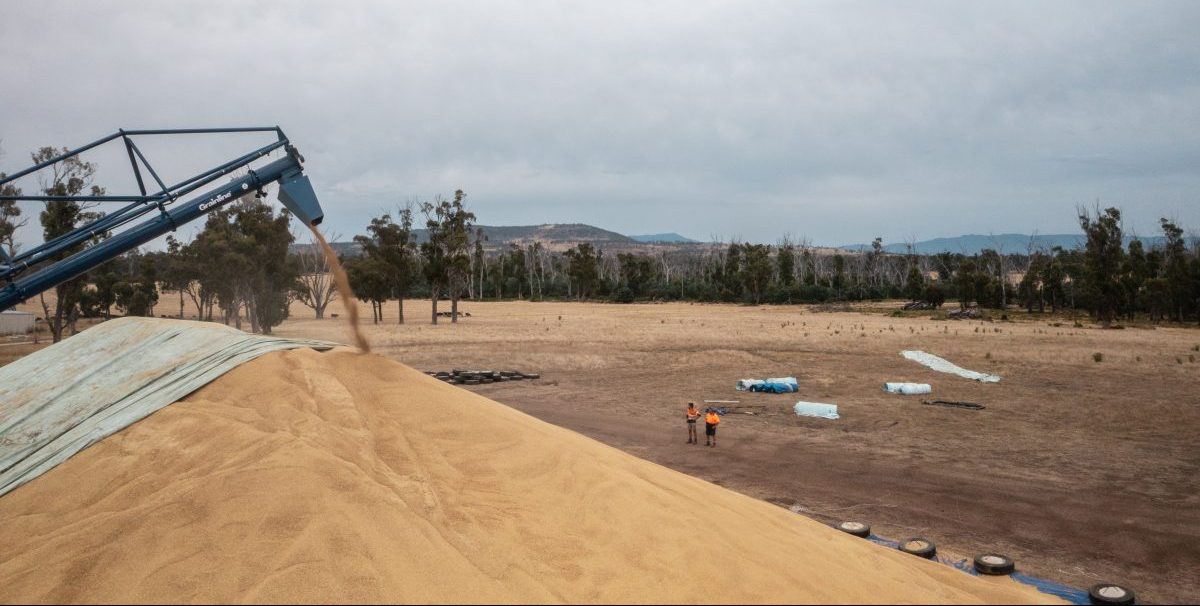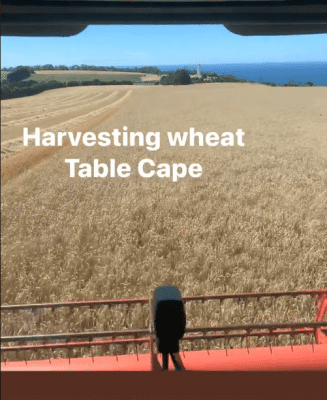
Wheat from the 2022-23 harvest is added to one of three bunkers at an XLD Commodities site at Powranna south of Launceston. Photo: XLD Commodities
THE island state of Tasmania has set a new harvest record over the summer just gone based on the biggest ever production of its three main winter crops: wheat, barley and canola.
ABARES estimates put production of the three crops combined at 153,000 tonnes, up 47 percent from the previous record of 103,800t set in 2021-22, and the bumper seasons in 2016-17 and 2020-21 which produced 92,100t and 91,400t respectively.
Kind seasons, and the arrival of new varieties grown, as well as agronomic guidance provided by the Hyper Yielding Crops project, are behind the recent jumps in production.
Funded by the Grains Research and Development Corporation and led by Field Applied Research Australia, HYC has helped growers achieve never-before-seen yields, and more marketable quality.
As Australia’s only state without a public bulk-handling system, the surge in tonnes produced is increasing the need for private storages and supply chains, and growers and businesses are responding.
| 2021-22 ha | 2021-22 tns | 2022-23 ha | 2022-23 tns | |
| Wheat | 9,300 | 70,000 | 15,000 | 82,500 |
| Barley | 4,300 | 24,000 | 11,000 | 60,500 |
| Canola | 3,600 | 9,800 | 5,000 | 10,000 |
| TOTAL |
17,200 | 103,800 | 31,000 | 153,00 |
Table 1: Area in hectares and tonnes produced for the 2021-22 and 2022-23 cropping years. Source: ABARES Australian Crop Report March 2023
Pleasing yields, exceptional quality
XLD Commodities is Tasmania’s biggest bulk handler, and its general manager John Tuskin said most growers had pleasing yields and good specs in the harvest just gone.
“The quality’s been exceptional this year,” Mr Tuskin said.
The proportion of malting received in barley well exceeded the norm of around 20-30pc.
“With the barley, about 50pc of the crop went malting.”
Mr Tuskin said wheat recorded some excellent yields at up to 10t/ha for dryland, and higher protein was around the 11pc mark.
Test weights varied from more than 80kg per hectolitre, and others spread throughout the 70s, with waterlogging and/or frost the cause of the lighter weights and some pinched grain.
Tasmania is a net importer of milling wheat from the mainland, and its own wheat goes into the feed market.
XLD is a major supplier of barley to Tasmania’s only large-scale malthouse, located in Devonport, and part of the French-based Boortmalt group.
XLD also accumulates canola, and Mr Tuskin said high oil content was a hallmark of the season.
“The average was above 46pc; the baseline is 42pc, so there were plenty of bonuses there for canola.”
Harvest in Tasmania can run into May, and Mr Tuskin said this year’s event was by no means late, with some hot and dry weather helping the crop to catch up after a wet spring.
“We could say it’s all but finished; stuff we’re seeing now is coming out of storage.”
“There are a few faba beans to come in; they’ll be harvesting this week.”
Tasmanian growers are already planting dual-purpose winter crops, and Mr Tuskin said XLD was looking at expanding its storage capacity to cope with increased production in the Midlands.
At its sites at Powranna, south of Launceston, XLD has received a little over 50,000t of wheat, barley and canola in total, in line with the previous harvest’s intake.
“There’s very little on farm storage; if the crop is a tad over 100,000t, we don’t have enough storage for it.
“We’re still keen to expand.
“We believe a new modern site will enable us to increase returns to growers”.
However, the Northern Midlands Council recently rejected an application from XLD to develop a greenfield site at Powranna.
XLD also packs containers, and Mr Tuskin said opportunities exist for canola and barley to be shipped to the mainland and overseas.
Solution found in north-west
The Midlands primarily provides grain milled by locally owned business Tasmanian Stockfeed Services, and Skretting and BioMar, Tasmania’s Scandinavian-owned aquafeed producers.
On Tasmania’s north-west coast, where dairying and horticulture are key industries, a group of growers has built their own supply chain to market grain which is grown too far away from the abovementioned consumers to be a logistic fit.

Harvesting wheat growing beside the Bass Strait in north-west Tasmania. Photo: Michael Nichols, Redbank Farming
Started by Sisters Creek grower Michael Nichols, it has this harvest aggregated 3100 tonnes of wheat and barley, with some corn to come, grown by 12 growers, and being sold direct to three local dairy farms.
“The dairy farms are milking 500-1000 cows, and they want to lock in a volume of grain,” Mr Nichols said.
The price is set in January, and Mr Nichols organises for around 250t to be outturned each month.
“It’s a consistent product, and (the dairy farms) have to deal with one person and not 12.”
He said the dairy farms take either straight wheat and barley, or a whole-grain blend which includes corn.
“We harvest corn in May-June, and that gets fed to cows in winter after calving.”
Thanks to mineralisation rather than applied nitrogen, wheat protein averages an astounding 14pc, which makes it a nutritionist’s dream.
“That’s why we’re so unique; we’re growing grain on red soil with 4-6pc organic matter.”
Mr Nichols grows potatoes over summer, and said others in the NWGP also grow potatoes as well as carrots and onions.
“Wheat really was grown as a break crop.”
Growing potatoes is expensive, and can account for close to half the income the crop generates, but they can yield close to 100t/ha and sell for around $450/t.
Therefore, cereals by comparison were almost an afterthought until a few years ago.
Mr Nichols said HYC findings have guided the north-west’s growers to new-found success with winter crops grown in a region with an annual average rainfall of around 1000mm.
It means wheat crops of recent years have been sprayed with a growth regulator and at least three fungicides.
“It’s a high-input growing area, and wheat these days will pretty well guarantee a yield of 9-10t/ha.
“If people are really pushing the envelope and trying to maximise yields, they can get around 11-12t/ha.”
Through HYC trials and new varieties, barley yields have jumped substantially, with Redbank Farming recently harvesting an 11t/ha crop of spring-sown Planet.
“A lot of spring barleys are now grown; people can get higher spring than winter yields.
“Winter barley did more like 7t/ha.”
Mr Nichols said because of Tasmania’s GM moratorium, introduction of new canola varieties is an expensive exercise for seed companies, who need to ensure seed integrity in order for it to land on the island.
Redbank Farming grows canola, but recent yield results have come in under expectations.
“We grew a TT variety that flowered too early, and we didn’t get the pollination we wanted because it was windy and raining.”
“Canola’s a missed opportunity.”
Grain-moisture managed
Mr Nichols said the HYC findings have helped his region move beyond the “stalemate” which occurred with older varieties.
“Our biggest limitation was moisture.”
NWGP growers are now able to give dairy farms a local supply option outturned at 12.5-13pc moisture, down from 15-16pc at harvest, thanks to a grain drier purchased in recent years, and the use of aerated silos.
“Before, we couldn’t get the security of harvesting to get to below 12.5pc, and they didn’t have ability to take high-moisture grain.
“Now we can harvest at 16pc moisture, dry it, and put it in the pool.”
Grain Central: Get our free news straight to your inbox – Click here

HAVE YOUR SAY